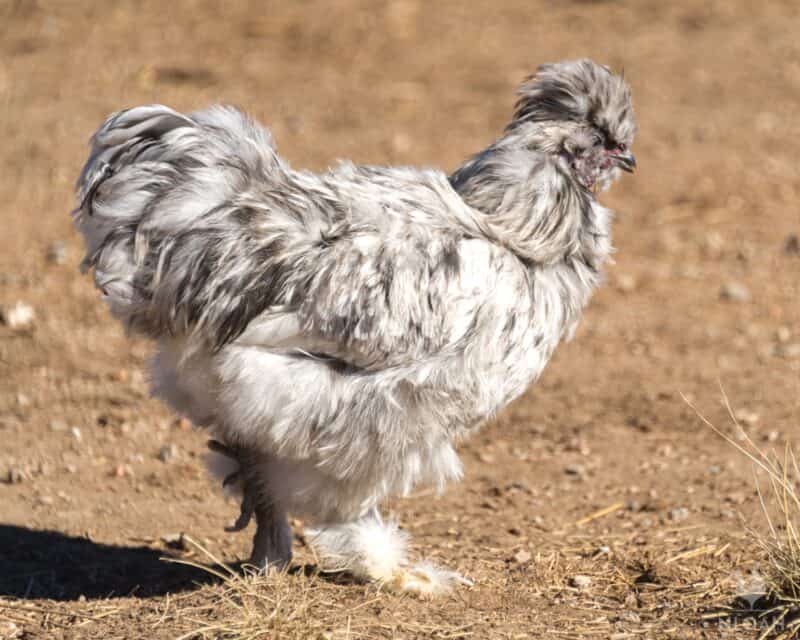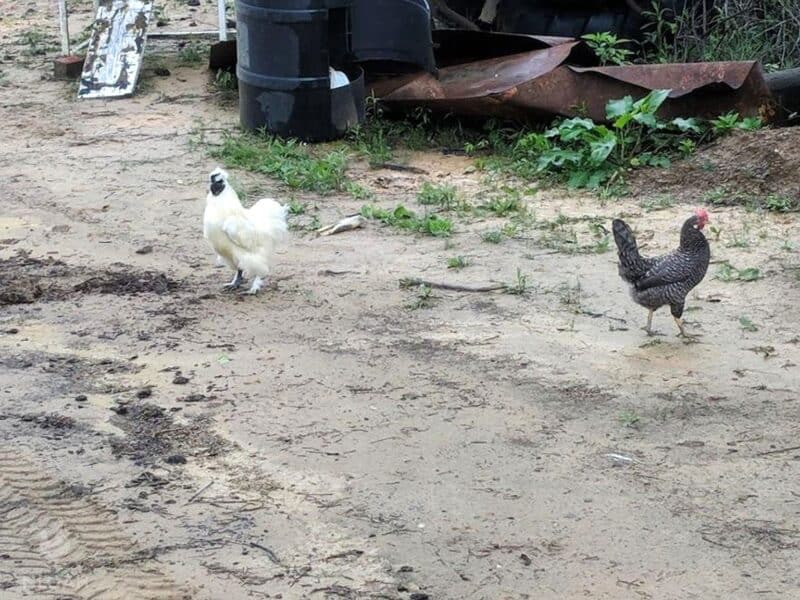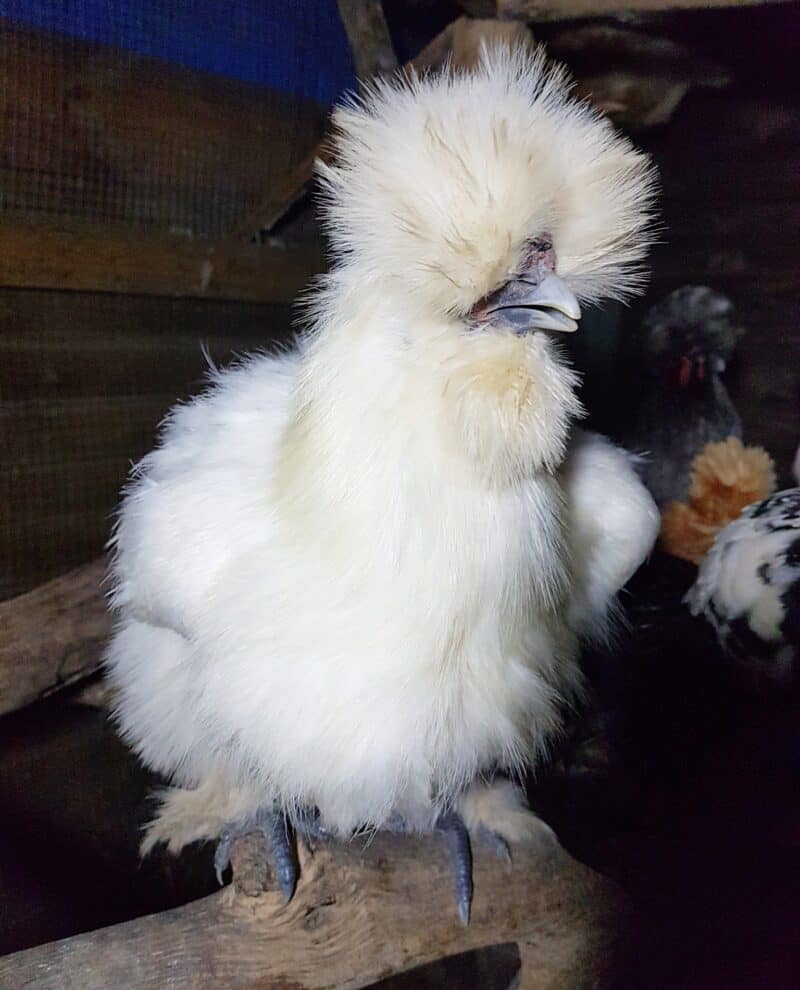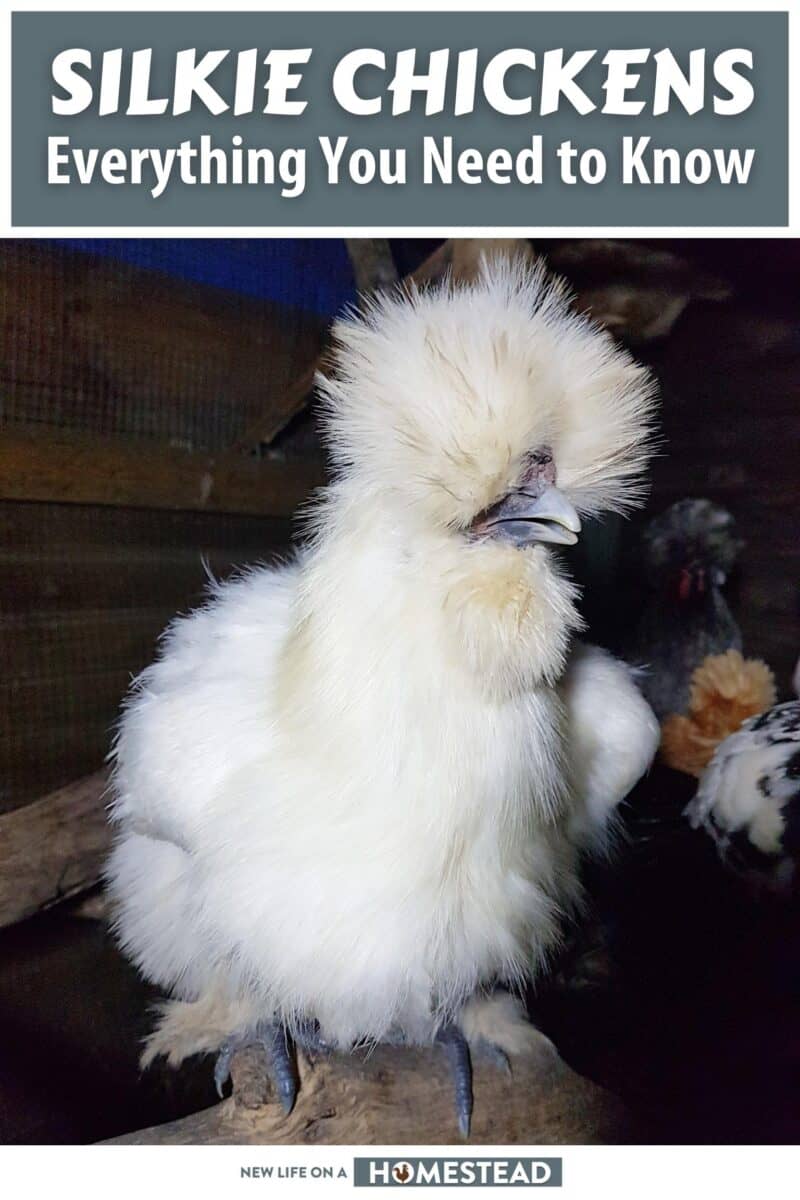Have you ever seen a chicken with feathers that look like they’re made of silk? That’s because they are called Silkie chickens! These unique creatures are known for their calm demeanor and soft feathers, which make them a popular choice for backyard farmers.

If you’re thinking about adding a few silkies to your flock, read on to learn more about these special chickens with fur.
Table of Contents:
What is a Silkie Chicken?
The Silkie chicken is a breed of chicken that is characterized by its fluffy plumage, which is said to feel like silk.
The breed has been around for hundreds of years and originated in Asia. Silkies are smaller than most other chicken breeds and lay fewer eggs.
However, they make excellent pets due to their docile nature and affectionate dispositions.
Silkies are also used in Chinese cuisine, where their meat is considered to be a delicacy. In recent years, the breed has become increasingly popular in the West as a show chicken.
| Name of Breed | Silkie |
| Best Uses | Companionship/exhibition |
| Average Size | 2 lbs |
| Heritage Breed? | Yes |
| Time to Maturity | ~10 months |
| Lifespan | 4 to 8 years |
| Variations | Black, gray, splash, partridge, buff, blue, white |
| Egg Size/Color | Small, cream |
| Egg Production | 100 eggs per year on average |
| Demeanor | Friendly |
| Broodiness | Yes |
| Flightiness | No |
| Noise Level | Quiet |
| Good for Beginners? | Yes |
| Good for Kids? | Yes |
| Hardiness | Yes |
What Color Do Silkies Come In?
Silkies are a type of chicken that is known for their silky, fluffy feathers. The Chinese Silkie chicken is truly one of a kind and is sometimes regarded as a “hairy chicken” because of its unique feathering.
Silkies are now recognized by the American Poultry Association and can be found in many different colors, including black, blue, buff, gray, partridge, and white.
You can find this breed in just about every color, including a white Silkie chicken and even a pink Silkie chicken!
What Does a Silkie Chicken Look Like?
Silkies are a breed of chicken known for their unusual appearance. Their most distinctive feature is their plumage, which is characterized by its silky texture.
These fuzzy chickens also have black skin and bones, and five toes on each foot (most chickens have four).
In addition, these birds are taller than other breeds of chicken, and they have a docile temperament.
Because of their unique appearance, these breeds are often used in shows and exhibitions. However, they are also popular as pets, and they make excellent mothers.
What Does a Silkie Rooster Look Like?
Silkie roosters are one of the most distinctive and easily recognizable chicken breeds. They are characterized by their unusually fluffy feathers, which have a silky texture.
Silkies are also relatively small birds, with males typically weighing no more than five pounds.

In addition to their unusual appearance, Silkie roosters are also known for being docile and good-natured.
As a result, they make excellent pets for children or beginners who are new to keeping chickens.
How Big Do Silkie Chickens Get?
Though they are not the largest chicken breed, they are still a good size for most backyard flocks.
Adult Silkies typically weigh between 4 and 6 pounds, with roosters being on the larger end of that spectrum. They are also relatively slow-growing, taking up to 24 weeks to reach their full size.
Silkie Polydactyly
This is a breed characterized by its black skin and bones, as well as 5 toes on each foot, instead of the usual 4. While this may not seem like a big difference, it’s actually quite rare in the chicken world.
In fact, less than 1% of all chickens have this genetic mutation known as polydactyly. While there is no real benefit to having an extra toe, some people find the Silkie’s unique appearance to be quite appealing.
As a result, these birds are often used in shows and exhibitions.
Are There Bantam Silkies?
Bantam silkie chicken breeds are one of the most popular breeds of chickens kept as pets.
Bantam silkies are smaller than standard silkies, and they typically weigh between two and four pounds. Because of their small size, they are often used as show birds.

Silkie Temperament and Behavior
In addition to their unique plumage, Silkies are also calm and docile nature. They make excellent pets and are known for being particularly good with kids.
Silkies typically enjoy being handled and will even allow themselves to be carried around like a stuffed animals. However, they can also be independent and sometimes would rather to cluck and scratch on their own.
Overall, Silkies make great companions and are loved by chicken enthusiasts for their sweet dispositions and unusual appearance.
Silkie Chicken Eggs: Do Silkie Chickens Lay Eggs?
One of the most common questions about Silkies is whether they lay eggs. The answer is yes! Silkies are good egg-layers, and their eggs are large relative to their body size.
In fact, Silkie hens are often used as brooders, or mother hens, for other chicken breeds.
How Many Eggs Do Silkie Chickens Lay?
Silkies typically lay around 100 eggs per year, but they may go broody (stop laying eggs in order to incubate them) more frequently than other chicken breeds.
While they may not produce as many eggs as some other chicken breeds, Silkies are still capable of laying eggs.
In fact, Silkie hens are often used as incubators for other chicken eggs, due to their ability to sit on the eggs for long periods of time.
What Color Eggs Do Silkies Lay?
In addition to their unique feathers, Silkies also lay white or cream-colored eggs. While the eggs of most chickens have a brown or blue tint, the eggs of Silkies are a pure white or cream color.
This makes them a popular choice for those who are looking for truly unique and beautiful eggs.
At What Age Do Silkies Lay Eggs?
In general, the average Silkie hen will begin laying eggs at around six months of age. However, this can vary somewhat depending on the individual bird.
Some Silkies may start laying a bit earlier, while others may not lay their first egg until they are seven or eight months old.
I was so excited when I found my first egg! I had been waiting for months, ever since I got my girls, and I was thrilled that they were finally old enough to lay.
Can You Raise Silkie Chickens for Meat?
It is possible to raise these birds for meat, though they are not typically grown for this purpose.
Silkies are a breed of chicken that is known for their fluffy feathers, which are said to feel like silk. They are also known for their docile nature, making them good pets.
However, Silkies are smaller than many other breeds of chickens, which can make them less ideal for meat production.
In addition, because Silkies are typically white-feathered, they may be more susceptible to sunburn.
If you do decide to raise Silkies for meat, it is important to take care to protect their skin from the sun.
Caring for Silkie Chickens
If you’re thinking of adding a Silkie black chicken to your flock, there are a few things you need to know about caring for these special birds.
Are Silkies Easy to Keep?
While they may look different from other breeds of chicken, they are actually quite hardy and easy to care for.
Silkies are excellent mothers and make good brooders, so they are often used to incubate eggs.
What Do They Eat?
When it comes to feeding, Silkies require a diet that is high in protein in order to support their rapid growth rate.
A simple diet of chicken feed supplemented with mealworms or other protein-rich foods will keep your Silkies healthy and happy.
I recently began keeping chickens, and one of the first things I had to learn was what to feed them. I quickly discovered that there is a lot of misinformation out there about chicken nutrition.
For example, I was frequently told that chickens need grit to digest their food, but this is actually not true.
Chickens have a gizzard, which is a muscular stomach that grinds up food without the need for grit if you are free-ranging your birds.
Since my chickens are able to collect their own grit, the grit I was buying was totally unnecessary.
However, chickens do need a diet that is high in protein and low in fat, as too much fat can lead to health problems. You really need to make sure you’re feeding your birds specialized feed.
I also learned that chickens should not be given any kind of processed food, as it can be difficult for them to digest.
Instead, they should eat a diet that consists mostly of fresh fruits and vegetables, grains, and insects.
Ideal Housing
While they make great pets, they have specific housing requirements that need to be met in order to keep them healthy and happy.
Silkies should be kept in a coop that has plenty of space for them to move around and stretch their wings. The coop should also have a nesting box for each chicken, as well as perches for them to sleep on.
In terms of the actual size of the coop, a good rule of thumb is to allow for about four square feet of space per chicken.
It is important to make sure that their coop is well-ventilated and does not get too hot in the summer months or too drafty in the winter.
Hardiness
Silkies are thought to originally come from Asia, and they are well-suited to hot weather. However, they can also do well in cold weather, as long as they have access to shelter and food.
Just make sure their feathered feet don’t get wet and stay wet. It can take longer for them to dry off.
Here are some tips I’ve learned about how to keep your chickens warm and dry:
- make sure they have a dry place to roost. If their coop is wet, they can get frostbite on their feet.
- you can put Vaseline on their feet to help prevent frostbite.
- if they do get frostbite, you need to quickly warm their feet up with warm water or a heat lamp.
- make sure you keep an eye on them and check their feet regularly during the winter.
Common Health Problems and Diseases
One of the most common health problems faced by these birds is respiratory issues. This is often caused by the breed’s small air passages, which can become blocked easily.
Silkies are also particularly susceptible to Marek’s disease, a viral infection that attacks the nervous system. Make sure you purchase vaccinated chickens.
Lastly, Silkies are prone to developing external parasites, such as lice and mites. This is due in part to their heavily feathered feet and other body parts.
While these problems can be serious, they can often be prevented with proper care and husbandry. Inspect your chickens often and make sure they have access to a dust bath.
Silkie Predators
Silkies are a type of chicken that is known for their fluffy feathers and docile temperament. Sadly, this makes them an easy target for predators. Dogs, cats, raccoons, and snakes are all common predators of them.
When I first started keeping poultry, I quickly learned that predators are a real threat. I lost two chickens to a hawk, and another to a fox. It was a difficult lesson, but I did learn some lessons the hard way.
First, I built a sturdy fence around the coop. This keeps out smaller animals like weasels and snakes. I also installed a chicken wire barrier around the perimeter of the yard. This deters larger predators like coyotes.
Finally, I made sure to keep the coop clean and free of food scraps. This minimized the chances of attracting rodents, which can draw in other predators.
My advice to you? Make sure the coop is well-built and has no gaps that a predator could squeeze through.
Consider investing in an automatic chicken coop door opener so your chickens go in and night and are protected.
Additionally, install a fence around the perimeter of the coop and bury it several inches deep to deter digging animals.
Finally, keep an eye on your birds and be alert for signs of predation, such as feathers near the coop or unusual behavior.
How Long Do Silkies Live?
So how long do these beloved birds typically live? Unfortunately, the answer is not as straight-forward as one might hope.
While some Silkies can live for upwards of 10 years, the average lifespan for a Silkie chicken is only 4-8 years. This depends on a variety of factors, including how well the bird is cared for and the climate they live in.
Where to Buy Silkie Chicks
The best place to buy Silkie chicks is from a reputable breeder. This will ensure that you’re getting healthy birds that have been properly socialized.
You can also check your local feed store or agricultural supply store. These places typically have a good selection ofSilkie chicks available.
When choosing your chicks, look for signs of good health, such as bright eyes and clear nostrils.
Silkie FAQ
While most chickens do not have hair, there is one variety known as the Silkie chicken that does have feathers that resemble hair. These feathers are called “Silkies” and they are softer than normal chicken feathers.
The Silkie is a breed of chicken that is characterized by its silk-like feathers. The feathers on their feet are especially long and soft, giving them a unique appearance.
Other chickens with feathered feet include the Cochin, Faverolle, Langshan, Belgian d’Uccle, and Booted Bantam, to name a few.
If you are interested in purchasing a Silkie chicken, prices can vary depending on the breeder and the location. However, you must know that Silkies are among the most expensive chicken breeds, and you can expect to pay anywhere from $15 to $75 for a healthy adult bird. For a chick, you’ll pay $3 to $10.
Silkies are known for having black skin and bones, as well as five toes on each foot, instead of the usual four. This genetic mutation is called polydactylism, and it is relatively rare in chickens.
Like other chickens, Silkies have wattles – fleshy protrusions that hang down from the lower side of their head. On the hens, the wattles are smaller and less pronounced than the ones on the roosters.
Wattles are used to regulate body temperature and play an important role in the chicken’s reproductive system.
Silkie chicken eggs take approximately 21 days to hatch. The process can vary slightly depending on the incubation conditions and the age of the hen, but generally, hatching takes place within three weeks.
During this time, it is important to maintain a consistent temperature and Relative Humidity (RH) level in the incubator.
If these levels fluctuate too dramatically, it can cause difficulties during hatching and may even result in death.
Once the eggs have started to hatch, it is also important to provide adequate ventilation to prevent the chicks from suffocating.
These chickens tend to have darker meat than other breeds of chicken. This is due to the fact that their skin is also black, which indicates that they have higher levels of melanin in their bodies.
Silkies are popularly kept as pets due to their docile and friendly nature. However, they are also good layers of eggs, and their meat is considered to be delicately flavored.
Silkies are not typically used for commercial egg production due to their low egg output, but they make up for this in other ways.
For example, their feathers can be used to make pillows and clothing, and their meat is often used in Chinese cuisine.
A Silkie chicken is a heritage breed of chicken that is characterized by its black skin, bones, and meat.
The flavor of Silkie chicken meat has been described as being similar to dark meat chicken, with a slightly gamey taste.
Chickens are not known for being particularly cuddly animals, but that doesn’t mean they don’t enjoy a good back scratch now and then.
Silkies are a breed of chicken that is known for being especially docile, and they seem to enjoy being held and petted.
In fact, many people who keep Silkies as pets say that they act more like dogs than chickens. They will follow their owners around, perch on their shoulders, and even sit in their laps.
Silkies are a popular choice for beginners, as they are relatively low maintenance and easy to care for.
Silkies are also known for being friendly and docile, making them enjoyable pets for both children and adults. In addition, Silkies are fairly hardy birds and can tolerate both hot and cold weather conditions.
Silkies are not typically used for egg production, as they have smaller bodies and lay fewer eggs than other chicken breeds. However, some people do choose to eat Silkies eggs, as they are considered to be a delicacy.
The flavor of Silkies eggs is said to be richer and more intense than that of other chicken eggs, making them a unique and sought-after treat.


Rebekah is a high-school English teacher n New York, where she lives on a 22 acre homestead. She raises and grows chickens, bees, and veggies such as zucchini (among other things).
